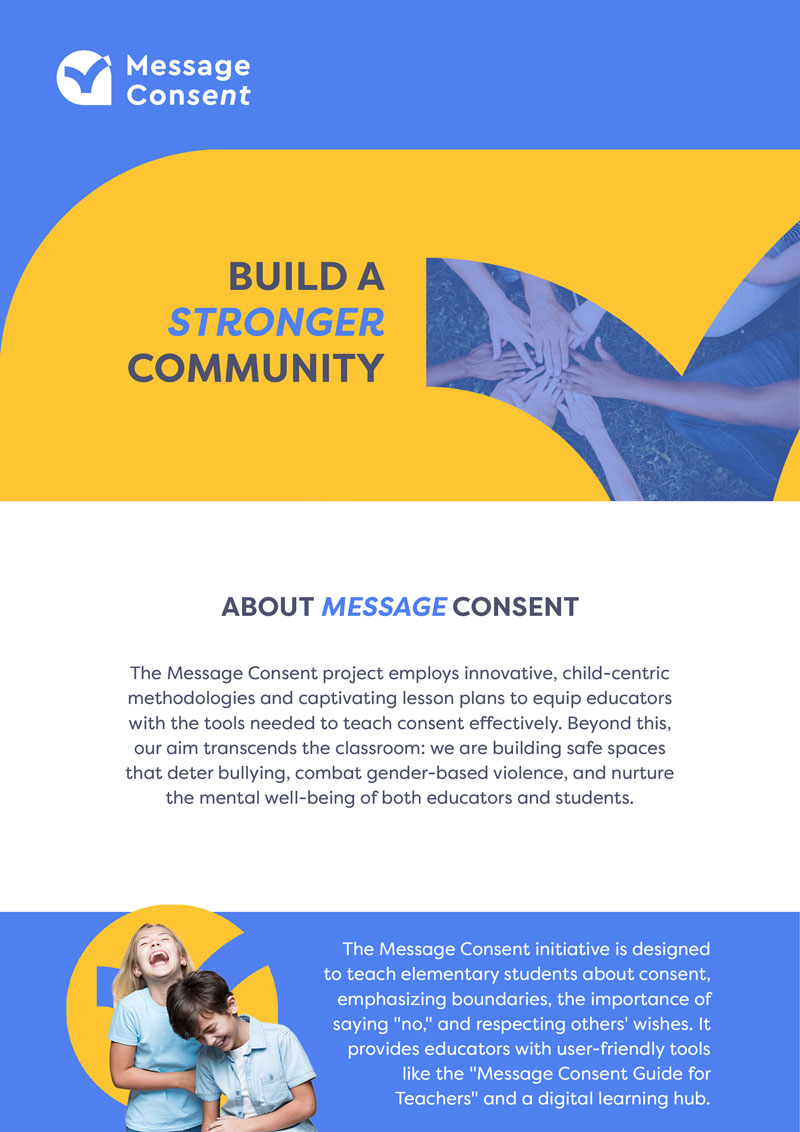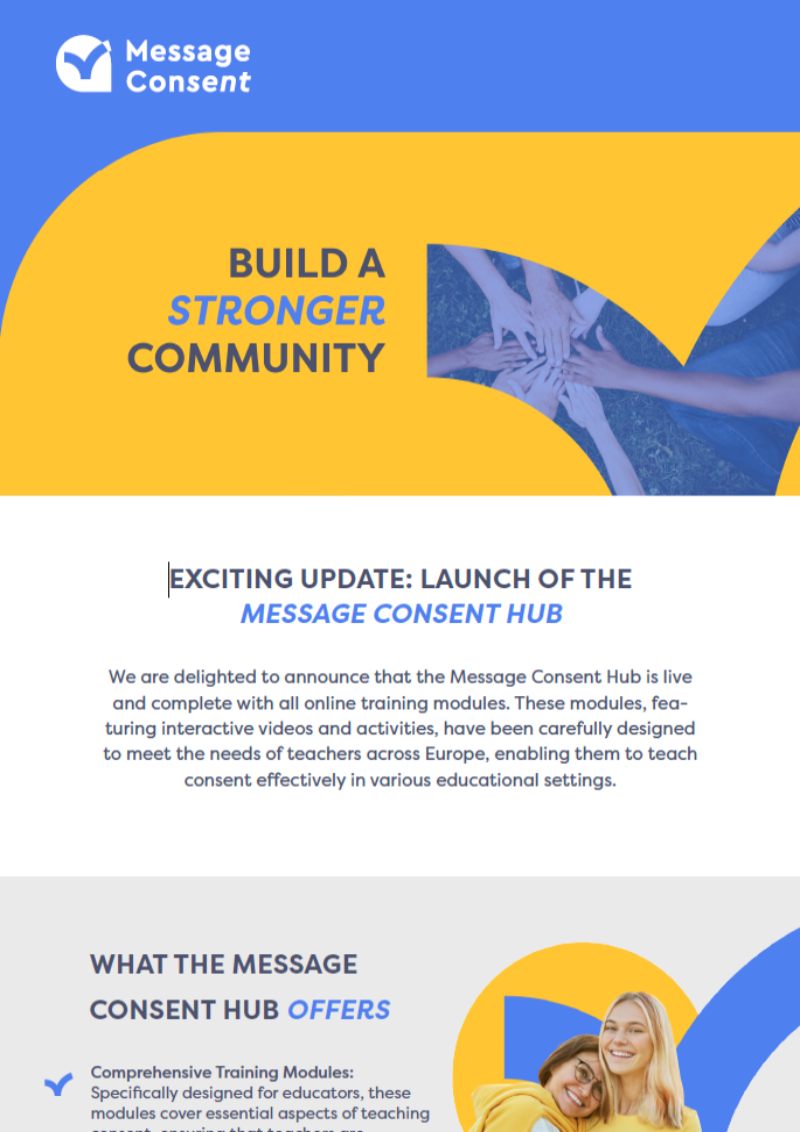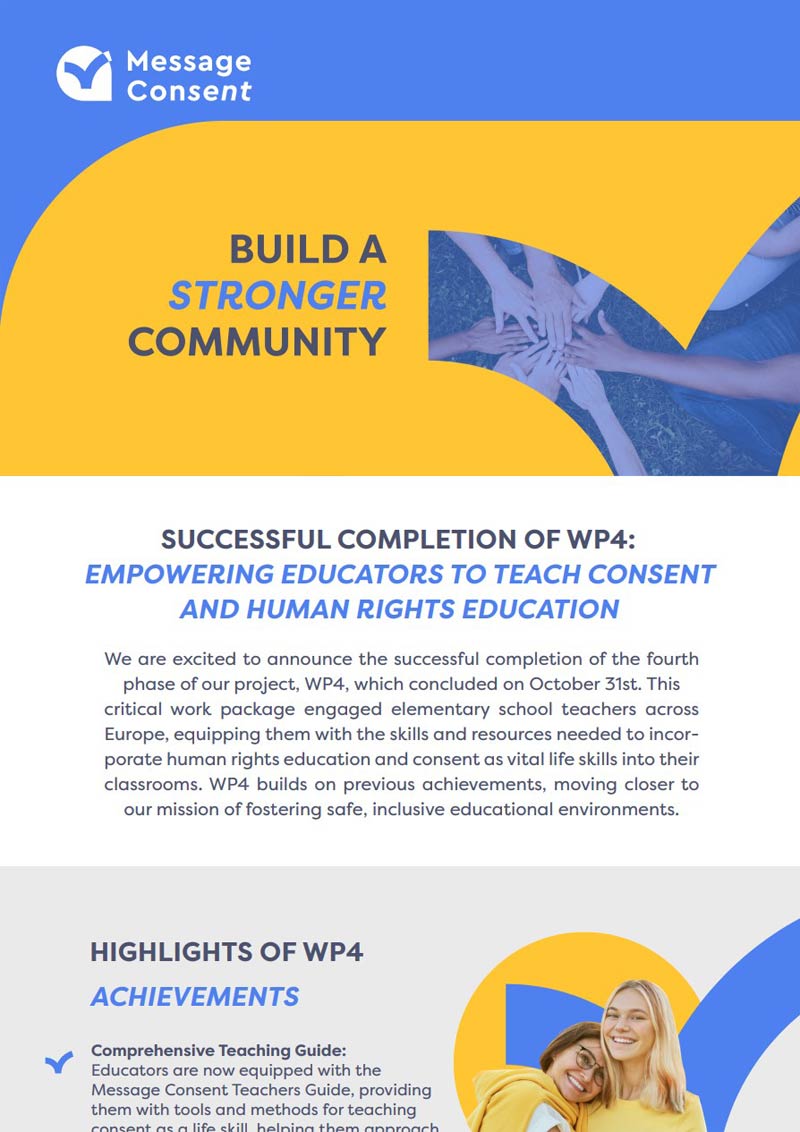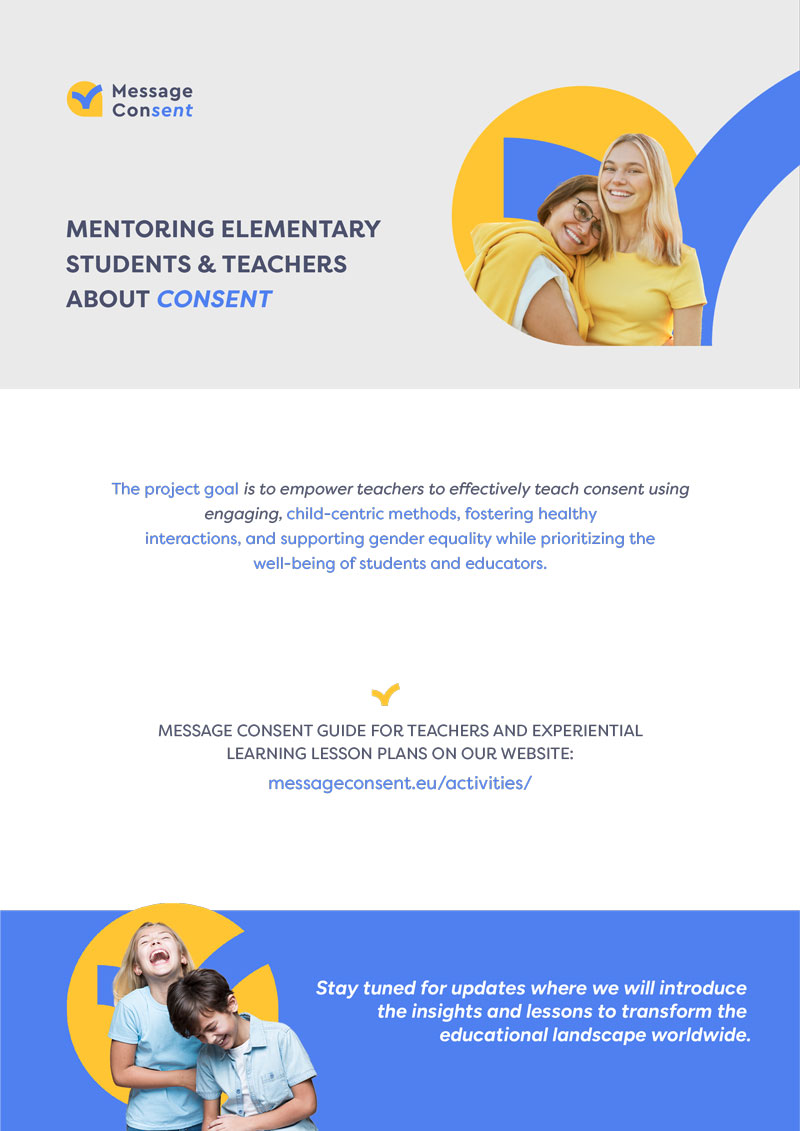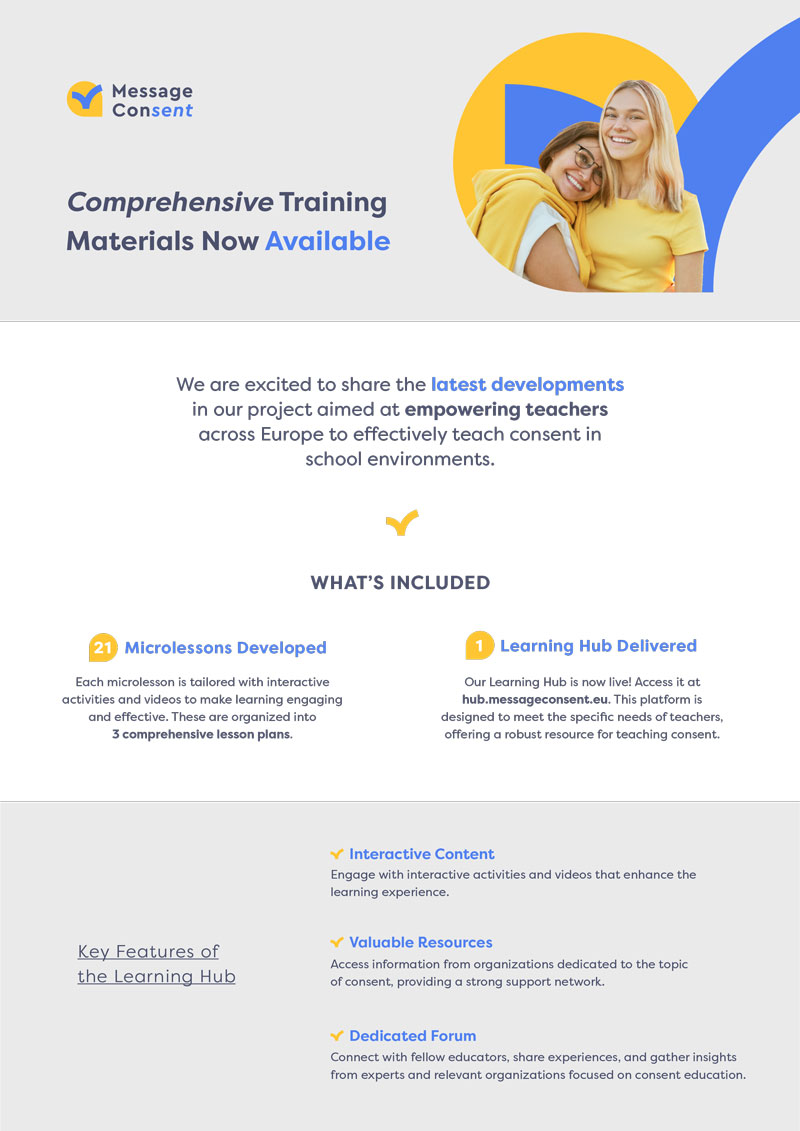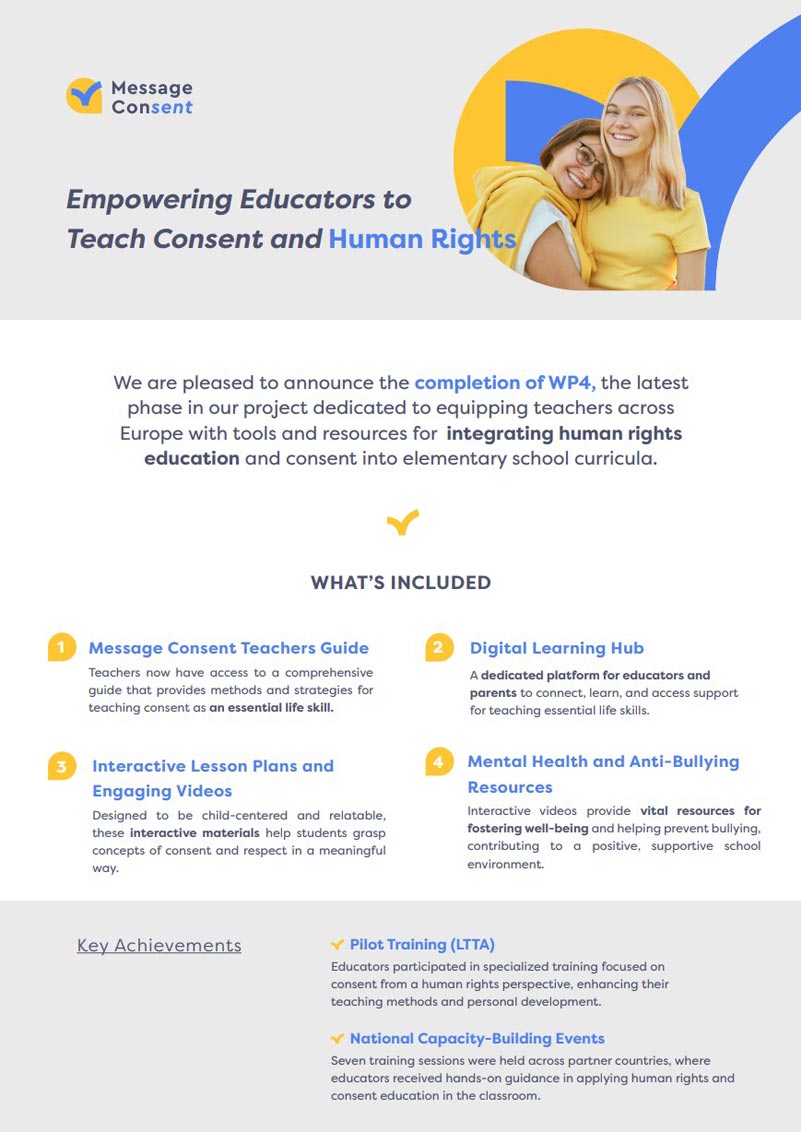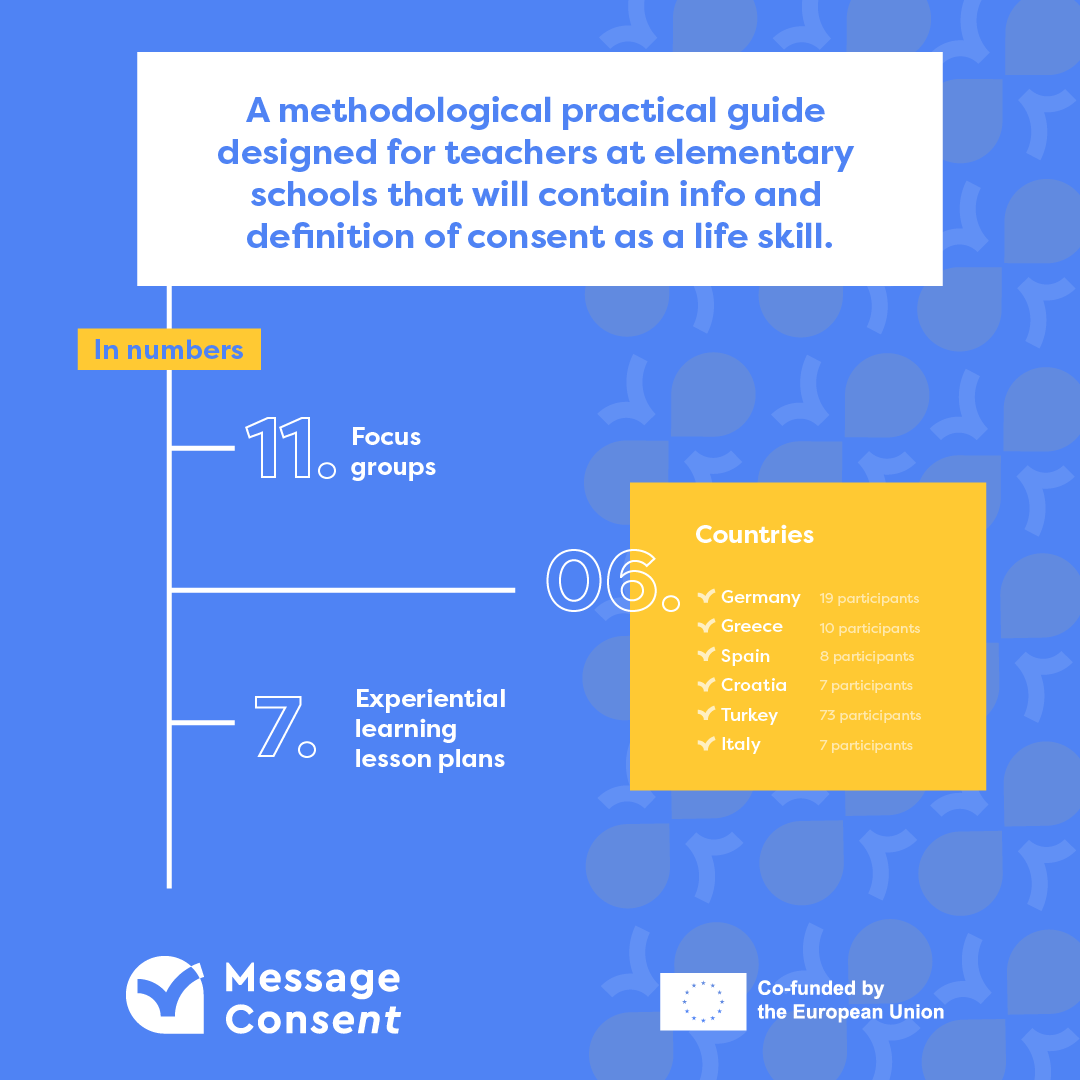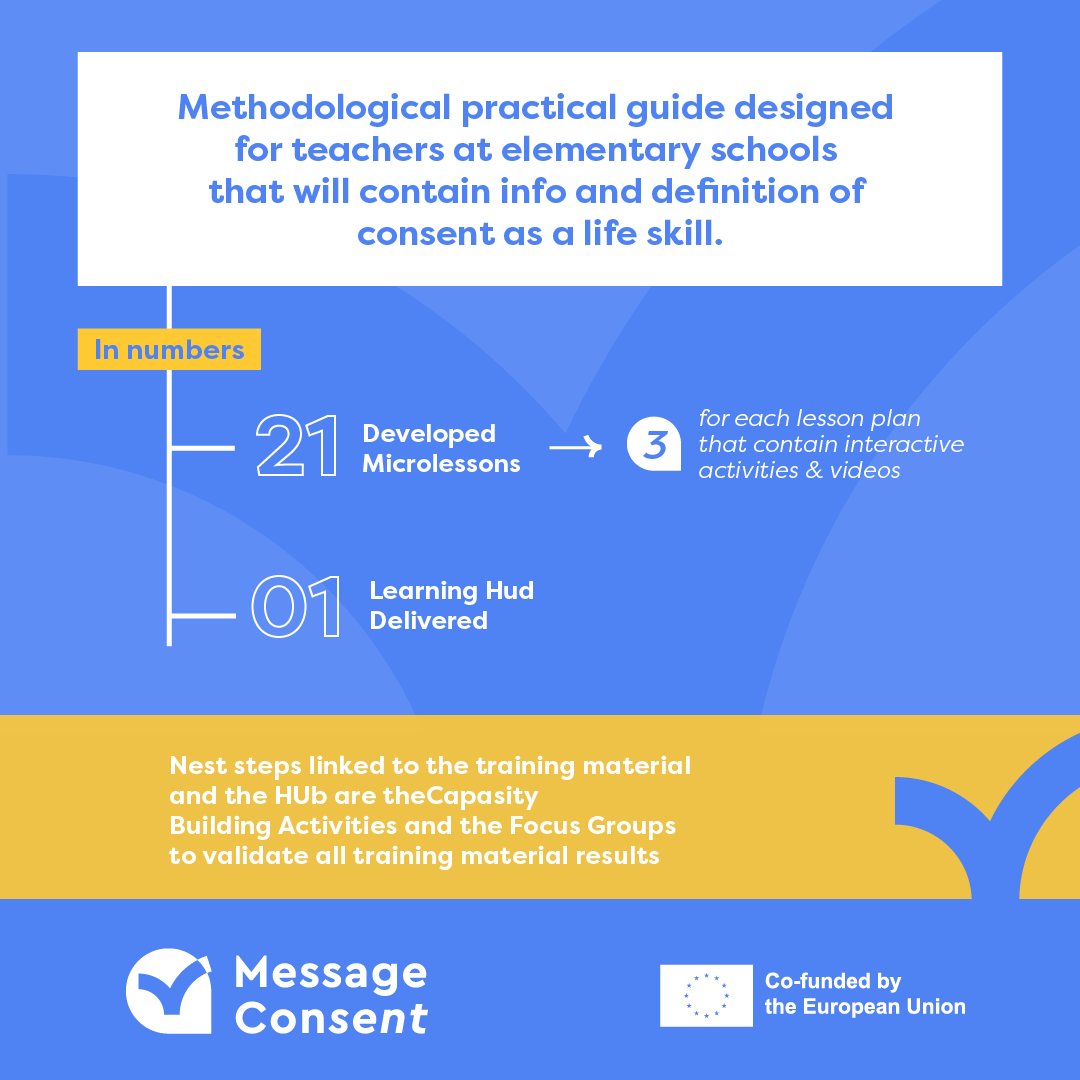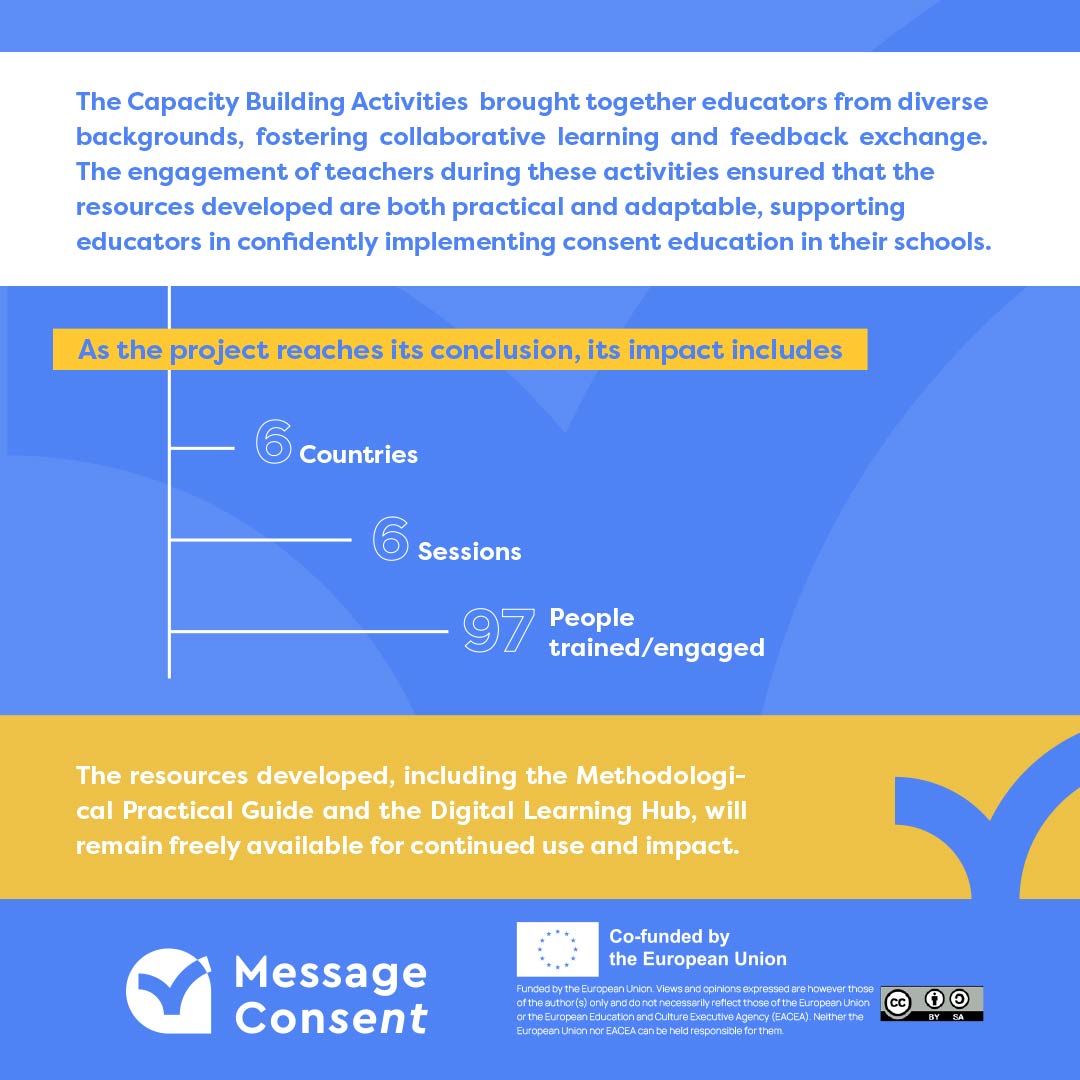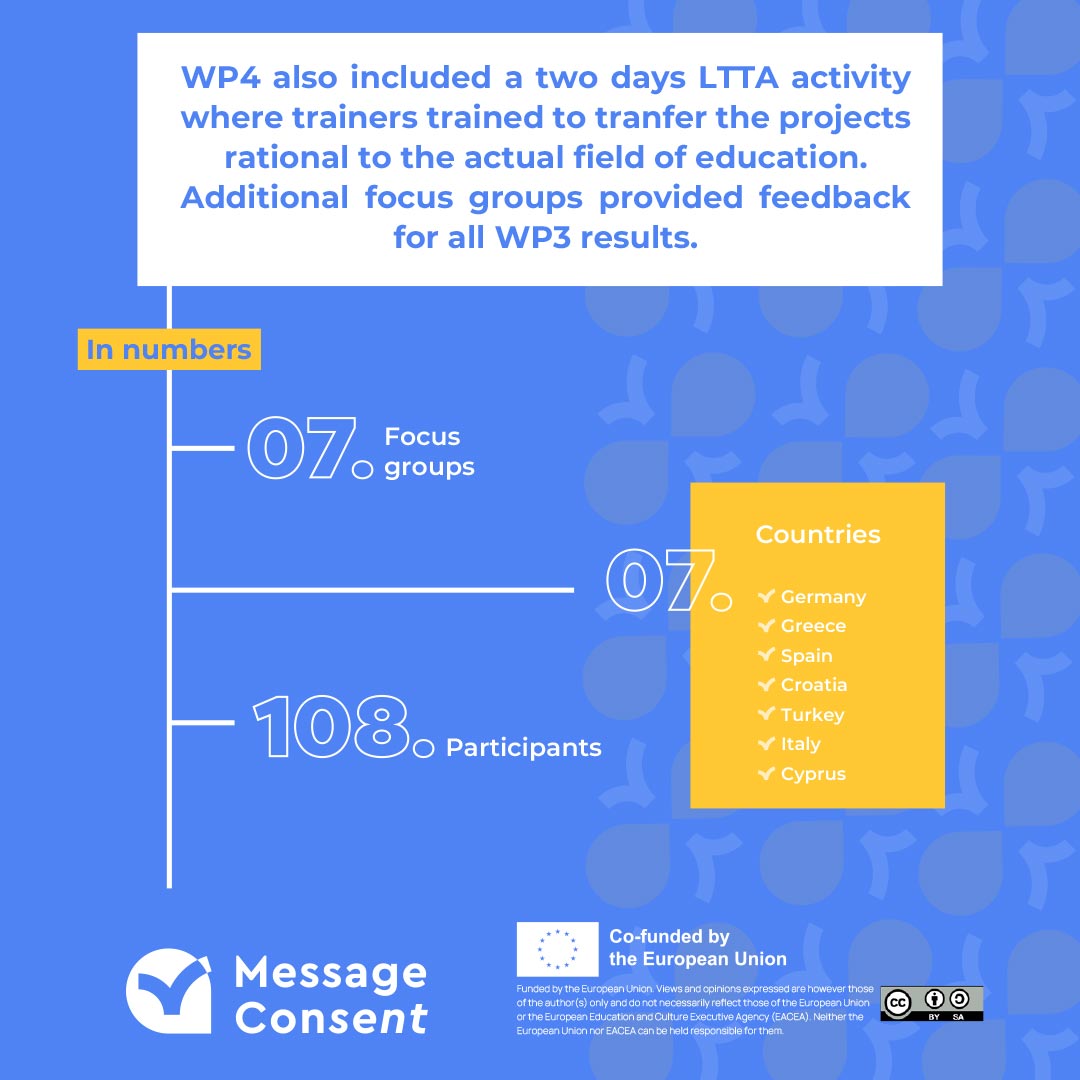Activities
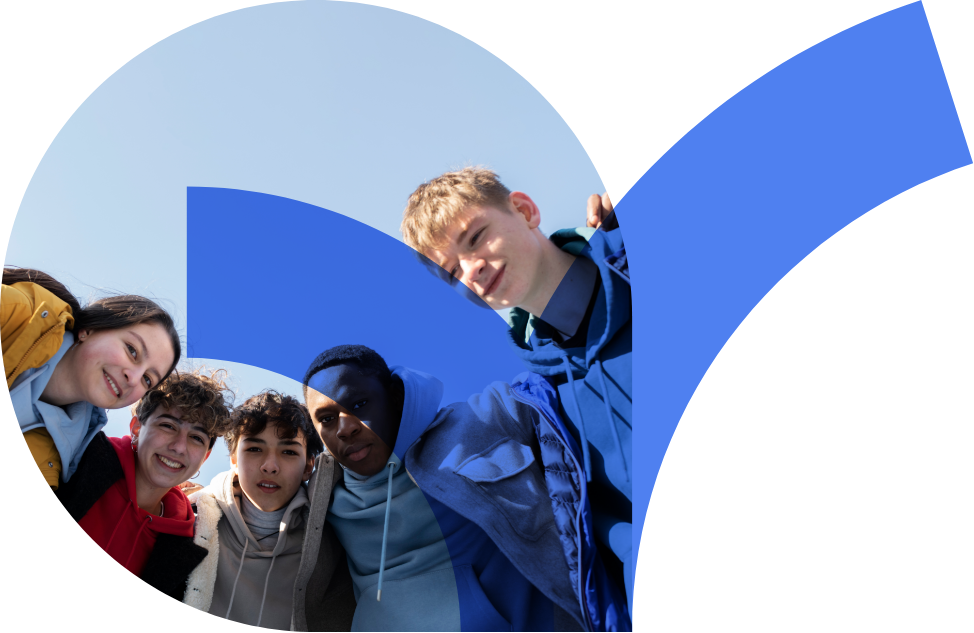
Message Consent Guide for Teachers & Experiential Learning Lesson Plans
Message Consent Guide is a practical methodological tool designed for elementary school teachers. It provides clear definitions of consent as a life skill and include best practices for teaching mutual respect, communication, conflict management, and boundary-setting. Additionally, it utilizes Human Rights Education (HRE) to teach students how to ask for and receive permission, and practice consent in all interactions. The guide features seven experiential lesson plans, each tailored for students ages 8-12, with appropriate guidelines, methods, tools, and tips for educators.
Guide For elementary School Teachers
Lesson Plan 1: Dealing with "no"
Overview
Learning to set and accept boundaries and to deal with “no” is one of the most difficult tasks for children, parents, and teachers. The goal of this workshop is for children to explore and understand the concept of saying "no" by drawing adequate physical and emotional boundaries (and communicating when these boundaries are violated) and respecting the boundaries of others.These activities are designed to increase children's self-confidence so that they can better assert themselves in difficult and dangerous situations and also respond empathetically to a "no".
A child learns his/her own boundaries and the boundaries of others best by practicing saying "no" and accepting "no" using different mimics and gestures.
Children/adolescents who grow up in a latently boundary-violating environment find it particularly difficult to maintain their own boundaries and those of others, or to seek help, because they permanently learn that it is "appropriate" to transgress their boundaries. It is the everyday task of educators, among others, to practice with children and young people to respect their own and others' boundaries, learn what not to accept, but also to be generous in confronting those who are weaker.
Learning Objectives
The following basic skills are taught during this class:
- How to perceive one's own feelings and how to deal with rejection and negative feelings
- How to deal with “no” and “yes”
- How to recognize and interpret one's own feelings and the feelings of others: intuition, acceptance, acting
- How to listen actively and clearly communicate
- How to respect others’ boundaries (practical respect for the right of every individual to define his or her personal space and acceptance of this right by every other person).
General Information
Duration: 90 minutes
Number of Participants: 12-15 students
Material Needed
- (Optional) unusual pictures to add challenge
- A railway barrier
- Pictures with “no”, “yes”, “stop”, “red light”, “green light”
- Pictures expressing feelings of acceptance/rejection
- The picture: "the lady throws the cheeky man to the ground by pulling his leg away"
Keywords
#other’s space, #boundaries, #yes, #no, #stop, #green light, #red light, #reflect, #circles, #forest
Activities
Activity Description
A space is needed for the planned exercises, which should be open and free of obstacles, ideally in the classroom where each child feels comfortable and safe. If the exercises take place outdoors, a comfortable, safe place is needed where the children can move freely and can draw a circle around themselves.
Introduction/Icebreaker: The Story of My Name (15min)
This introductory exercise helps the group to feel more comfortable and engaged to the main part of the lesson plan Children sit down in a circle and one by one start talking to the group about the story and the origin of their name. For example, ‘My name is Maria. I was given this name because when I was born my grandmother died. Her name was Maria, she was a really loved person for the whole family and I was given this name in her memory’.
**the teacher/coordinator of the team starts first so that the rest of the group can follow in the same way.
Closeness and Distance/ Stop and Hold: Exploring your own and others’ boundaries! (15min)
*This exercise is meant for children to recognize how far they can go about their physical and mental space. They learn how to express their feelings and to accept the spaces and feelings of others. Each child looks for a partner and both line up in two rows facing each other. Row A stands still, and row B slowly walks towards the other child. Child A should sense when the other child is getting too close and then say stop! Child B should "provoke" and play with the closeness and distance so that the child gets a feeling for whether the stop came too early or too late or just right. Everyone does this 3 times, then the roles are exchanged In a second round, special emphasis can be placed on how the stop and halt are said. Does it come across convincingly, does the other person really mean stop or not?
Once the exercise is completed, we discuss the following:
Questions for Reflection:
- How did you feel?
- Were you bothered by the other’s closeness/distance?
- Did you manage to implement “stop” and also accept “stop”?
- Was it hard to stop and accept to stop?
- What was the hardest part?
Short exchange in groups of two, on how to be aware of feelings and commands:
The next two exercises are meant for children to recognize their own feelings and the feelings of others by repeating requests and refusals.
Please, Please (15min)
The aim of this exercise is to familiarize children with saying and accepting “no” in different ways and dealing with consent.
Two children face each other. Child A says "please, please" - in all possible variations (loud, quiet, questioning, determined, with certain mimic and gesture) and child B has to stand firm and say "no". As soon as B starts laughing, the roles are exchanged.
Questions for Reflection:
- How did you feel to say “please”?
- How did you feel to say “no”? How easy/difficult was it?
- Why did you start laughing?
Exploring the Enchanted Forest (30min)
This activity helps children understand the concept of personal space and respecting boundaries in a fun and imaginative way. Gather the children in a circle in an open space (indoors or outdoors). Explain that you are going on an adventure to explore an enchanted forest where the trees and bushes are represented by the children themselves.
Imaginary journey:
- Ask the children to close their eyes and imagine themselves walking into the enchanted forest.
- Describe the features of the forest: towering trees, lush bushes, colourful flowers and magical creatures.
- Explain that in this enchanted forest, each child can decide for themselves how close or far away they want to be from the other 'trees' and 'bushes'.
Exploration of personal space (15 minutes)
The children are divided into groups and each group represents the trees and bushes of a forest or thicket.
The children arrange themselves in the space according to their group and spread out to imitate the forest.
The game:
- Each child takes a turn to walk through the "forest" created by the other children.
- They can decide for themselves how dense or airy they would like the forest to be.
- They communicate their preference to the other children, who adjust their positions accordingly to create the desired density.
- The child then walks through the adapted forest and experiences the space they have created.
Density levels:
- The density of the forest can range from 1 to 10, with 1 being very sparse (lots of space between the trees) and 10 being very dense (little space between the trees).
- The children can express their desired density verbally or through gestures, which allows for flexibility and creativity when designing the forest.
The role of the players:
- The children, acting as trees and bushes, respond to the wishes of the child walking through the forest and adjust their positions to create the desired density.
- They actively listen and work together to create the forest according to the walker's wishes.
Gather the children back together.
Ask them to talk about their experiences (10 minutes):
- How did it feel to explore the enchanted forest?
- Did they enjoy having control over their personal space?
- What did they learn about respecting boundaries?
Thank the children for their participation in the enchanted forest adventure.
Remind them to always respect their own and others' personal space, just like they did in the activity.
Debriefing/ evaluation: Reflection on the overall lesson (15 minutes):
Questions for exploring boundaries and dealing with "no" and rejection.
- The purpose of the above exercises is to learn to respect the boundaries of others, to recognise and interpret one's own feelings and the feelings of others, and to communicate and respond intuitively to rejection.
- All participants are asked how they felt during the games. The teacher then collects the feedback either verbally or in writing. Everyone shares their experiences, especially after the last game where proximity/distance plays an important role.
Useful Tips for Teachers
- It is important for teachers to help children to learn how to say “no” and how to accept “no”.
- After these exercises, children should be able to recognize and respect the boundaries of others and also set boundaries themselves when they get into a situation that is unpleasant for them. The teacher will observe their behavior during the exercises and when necessary, intervene.
- The aim of the games is to strengthen the pupils' personality and self-esteem, to promote their life skills and to improve their problem-solving ability.
- Children should be encouraged to express their opinions and describe how they felt when other children put them in uncomfortable situations and how easy/difficult it was for them to say "no"/"yes".
Lesson Plan 2: Let's agree to disagree
Overview
The aim of this workshop is to familiarize children with the concept of conflict management, especially emphasizing the importance of mutual respect. These activities will allow students to foster their empathy and acceptance of others, and develop their communication and problem-solving skills while also establishing a respectful and inclusive environment.Learning Objectives
The following basic skills are taught during this class:
- To explore the different causes of conflicts and how they can impact relationships and individuals.
- To improve one’s ability to express opinions, feelings, and needs.
- To foster empathy and respect towards others’ opinions, therefore encouraging inclusion and understanding of diversity.
- To explore the potential of active listening, problem-solving and negotiating skills to achieve the best outcomes of potential disagreements.
- To reflect on different ways and methods on how to resolve conflict situations.
General Information
Duration: 90 minutes
Number of Participants: 4-24 students
Material Needed
- An inside space that is known by the children in order to make them feel more safe and comfortable (a classroom would be perfect)
- Projector and screen (for the 2nd activity)
- One orange (for the 3rd activity)
- Flipchart and markers (for the 3rd activity)
- Whistle (for the 3rd activity)
- Three A3 size signs with drawn on smiley faces (for 4th activity)
Keywords
#respect, #communication, #active listening, #understanding, #diversity
Activities
Activity Description
A space is needed for the planned exercises, which should be open and free of obstacles, ideally in the classroom where each child feels comfortable and safe. If the exercises take place outdoors, a comfortable, safe place is needed where the children can move freely and can draw a circle around themselves.
Introduction/Icebreaker: Pass the compliment (15min)
*This introductory exercise helps to create a supportive environment among the group, allowing the students to feel more comfortable and engaged in the main part of the lesson plan.
Ask the students to sit in a circle. Explain that their task in this activity is to give compliments to each other around the circle. Begin by complimenting the student sitting next to you, stating their name. For instance, "Sarah, I really appreciate your creativity in art class". Instruct the student who got the compliment to pass it on to the person next to them, giving their name. Encourage them to consider the person's good characteristics, talents, or behaviors.
Enrichment of knowledge: Why are there conflicts & how can we resolve them? (25min)
*This activity will allow students to discuss different causes on why disagreements might happen, what are peaceful ways to solve conflicts and reach a compromise. (Please explain the aim of this activity to the students at some point - either right after the activity, or during the debriefing, whichever feels more suitable).
Set up a screen with the following video on display: “Conflict resolution: How to settle your differences fairly | BrainPOP”
https://www.youtube.com/watch?v=jg_q34kgskg
Gather the students to watch it. Explain to the students that they need to pay attention to what is discussed in the video, as afterwards they will have to answer questions. Once the video is finished, discuss with the students the following:
Questions for Reflection:
- What was the reason for the disagreement mentioned in the video? What other causes for arguing can you mention?
- How did the siblings decide to solve the problem?
- Why was it necessary for the brother and sister to share their feelings about the topic? Did it help them to reach a solution?
- What was the solution that the brother and sister agreed on? Do you have any other ideas on how their argument could be solved?
Exploring conflict management: The Battle for the Orange (30min)
* This exercise encourages group competition and further discussion on how to resolve conflicts. It is designed to explore the need for communication and mutual understanding in a conflict situation in order to reach a compromise. (Please explain the aim of this activity to the students at some point - either right after the activity, or during the debriefing, whichever feels more suitable).
Before the start of this lesson, prepare a flipchart and write on it 4 rules for the game that will be revealed later on in this activity (do not display it to the students immediately):
- Do not use violence and fighting to get what you want.
- Be respectful and kind to others even if you don’t agree with them.
- Talk it out - explain your feelings, and listen to the others.
- See if there is a way you can both be winners in this situation.
If the class has been seated during the previous activity, free up the room so that the space would be open, without obstacles (such as chairs) in the way. Explain to the students that they are going to play “the orange game”. Divide them in two equal groups, group A and group B. Ask group A to go outside and wait for you. Meanwhile, tell group B that their goal in this exercise is to get the orange, because they need its juice to make orange juice. Then, go outside and tell group B that their goal is to get the orange, because they need its peel to make an orange cake. Gather both groups together, and explain that they have three minutes to get what they need. Place one orange between the two groups and say, “go.” After three minutes, blow the whistle and say “time’s up.”
Reveal to the students the flipchart with the 4 rules written on it. Once you have explained the rules, tell the students that they have additional three minutes to get what they want. After the three minutes are up, and depending on what is the outcome of the game, discuss with them the following questions:
Questions for Reflection:
- What was your group’s goal in the activity?
- How did your group try to solve the situation in the beginning?
- After discussing the rules with the teacher, did you try another approach?
- What was necessary in this activity for both groups to reach a compromise?
- Do people always want the same thing in a conflict? How can it affect the disagreement?
Debriefing/evaluation: Reflection on the overall lesson (20 min)
*This activity will allow students to reflect on the learning objectives, as well as foster the ability to express their thoughts and feelings.
Before the start of this lesson, prepare three signs with smiley faces drawn on it (one happy/one neutral/one sad) that will be used to gain feedback on how the students feel about the activity.
Place the signs in three different parts of the room, so the students can stand next to them. Ask the students to choose the sign that best represents how they feel about this lesson. Then, discuss the following questions:
Questions for Reflection:
- How do you feel after this lesson? Why?
- What part from this lesson did you like the most?
- What have you learnt?
Useful Tips for Teachers
- Make sure everyone feels safe and included during the activities.
- Pay attention to how the games are going and help if there are any problems.
- Say nice things when someone does a good job in the games.
Lesson Plan 3: Delivering the Message
Overview
The purpose of this lesson plan is to introduce the concept of effective communication and interaction among students. Through experiential and symbolic exercises, participants will have the opportunity to try out ways of interacting and examine their communicative functionality with regard to both their personal needs and the needs of others.Learning Objectives
The following basic skills are taught during this class:
- Effective communication (refers to ways to exercise my right to my personal space and accordingly accept this right from any other person without impeding our communication).
- Exploring ways of effective communication based on personal needs and expectations towards third parties.
- Deconstructing prefabricated ways of communication. Communicate in ways that feel right for me and make me feel comfortable.
- Conveying simple examples of effective communication and linking them to the concept of consent.
General Information
Duration: 90 minutes
Number of Participants: 12-20 students
Material Needed
- 12 small balls
Keywords
#effective, #communication, #interaction, #respect, #adjustment
Activities
Activity Description
A space is needed for the planned exercises, which should be open and free of obstacles, preferably without stimuli that can be disruptive for children. Ideally, an inside place known by the children would make them feel even more comfortable throughout the process.
Introduction/Icebreaker: The Story of Our Team! (20min)
*This introductory exercise helps the group to feel more comfortable and engaged in the main part of the lesson plan.
The children stand in a circle. They are instructed that they will all make up a story together by adding an animal name and an action. The animal will represent their favorite animal, while the action will be about something the children themselves enjoy doing. The facilitator starts first and then we go in circles. It is important to instruct the children that each phrase should be connected to the next by a link (and, then, to the next) as our aim is to create a unified story. Finally, the group facilitator concludes the story with the phrase 'and all the animals decided to work together for a common purpose!'
Enrichment of Knowledge: Poor Listeners! (40min)
*This exercise aims to empower each child to express their feelings when they are not listened to and organize/prepare their reactions.
Students sit on the floor in a circle, and a volunteer leaves the room while the others agree on how they will behave as the bad guys "listeners". Each chooses to clearly demonstrate a lack of interest and lack of attention to the "speaker". Looking the other way, scratching, cleaning their fingernails, looking at their watch, coughing, etc. The speaker then returns to the room, sits in the middle of the circle, chooses the most interesting film he/she has recently seen or tells something pleasant about his life (birthday, outing, etc.) and starts talking. We interrupt the role-playing after a while and all listeners applaud the speaker. Once the exercise is completed, we discuss the following:
Questions for the listeners:
- How do you think the person speaking felt while you were not listening?
- If you were the speaker, how would you have reacted?
- Have you thought about how this conversation could have turned out?
- Were there negative and positive outcomes of this process in your mind?
Questions for the speaker:
- How did you feel?
- What did you feel like when no one was listening?
- How would you have felt if you felt like you were being heard when no one was listening to you?
- How could you describe when no one was listening?
- What would you think as a solution in a case that no one is listening to you?
Resilience and Inclusion: Throw the Message! (20min)
*The aim of this exercise is for the participants tο understand that the body reacts automatically when receiving messages, to gain control of these reactions, to practice controlling the rhythm and duration of the messages received but also those that they send.
The plenary is divided into three groups. We give each group a ball and invite them to start throwing it to each other and create a steady stream of throws. Each member always throws the ball to the same person/teammate, saying his name at the same time. Once the flow is established, we give each team a second ball, and once the throwing flow is stabilized, we give a third, maybe even a fourth.
Usually, as the number of balls increases, the rate of pitching instead of slowing down speeds up. We stop the game and discuss the problems that occurred. We clarify the symbolism of throwing the ball (= messages in our daily life).
Questions for Reflection:
- Why were many ball throws missed?
- When we send messages back and forth, do others have time to catch them?
- What solutions might there be for better communication? (e.g., do we notify the other team member-receiver, slow down, etc.).
Debriefing/evaluation: Thoughts about ways of communication (10 min)
*Understanding personal ways of communication, respecting others’ boundaries on communicating effectively are the learning goals of this lesson plan. Let’s reflect on the gained knowledge!
Open question for the participants. The teacher asks about the experience and collects feedback verbally. The teacher also shares his/her experience with the group.
Useful Tips for Teachers
- Your active participation helps children to join and participate in this experiential workshop.
- It is important to maintain the playful and voluntary nature of the workshop for each child.
- It is important to have insight into the child and to be able to stop his/her participation if he/she feels uncomfortable or does not want to continue.
- It is important that the space in which the workshop takes place is circular in order to have a view of the children and thus make the whole process safe.
- It is ok not to have answers for everything. Discuss with your team what you found difficult or didn't expect to happen and reframe at a later time in the children's group if necessary.
Lesson Plan 4: Mirroring Respect
Overview
The activity "mirroring respect" is designed to foster consent and mutual respect among children aged 8-12. Through guided discussions, learning dance moves, and participating in a dance session, children will have the opportunity to express themselves while honoring personal boundaries and seeking consent from their peers.Learning Objectives
The following basic skills are taught during this class:
- Consent understanding: through discussions and dance activities, children will develop a clear understanding of consent, its importance, and how to seek and respect consent in different situations.
- Mutual respect promotion: by engaging in respectful interactions and respecting personal boundaries during the dance session, children will learn the value of treating others with respect, empathy, and kindness.
- Effective communication: the activity encourages children to practice effective communication skills, such as asking for consent, expressing personal boundaries, and actively listening to others' preferences.
- Self-expression and confidence: through creative expression in dance, children will build confidence, nurture their unique identities, and appreciate the significance of embracing and celebrating diversity with respect.
- Empathy and perspective-taking: through discussions and reflection, children will cultivate empathy by understanding and respecting others' perspectives, feelings, and boundaries. They will learn to consider the impact of their actions on others, fostering compassion and understanding.
- Real-life application: the workshop equips children with practical skills to apply in their daily lives, enabling positive social interactions, healthier relationships, and the establishment of a culture rooted in consent and mutual respect.
General Information
Duration: 90 minutes
Number of Participants: 8-20 students
Material Needed
- Open space or dance area
- Music device or device with speakers
- Hula hoops or tape
Keywords
#Respect, #mirroring, #boundaries, #dance
Activities
Activity Description
To prepare for the "Mirroring Respect" workshop, ensure that you have a suitable space for children to move freely without obstacles. Create a playlist of lively and age-appropriate songs to set the mood. Prepare discussion questions to guide conversations on consent, respect, boundaries, and communication. Familiarize yourself with simple dance moves appropriate for the age group. Set up visual markers (with the hula hoops or the tape) to define personal dance spaces. Ensure adequate adult supervision and communicate safety guidelines. Prepare words of encouragement to acknowledge and reinforce respectful behaviors during the activity.
By adequately preparing, you can create a secure and engaging environment for children to explore the ideas of consent, respect, and personal boundaries through dance and self-expression.
Introduction/Icebreaker (15min)
*This icebreaker activity aims to create a positive and engaging atmosphere, allowing children to get to know each other and feel comfortable within the group. Help break the initial barriers, encourage social interaction, and set a friendly tone for the rest of the activity.
During the icebreaker phase of "mirroring respect," an activity called “name dance” is introduced. Participants form a circle and take turns sharing their names while performing a basic dance move. The facilitator begins, passing the move to the next child, who continues the pattern. This interactive game helps children learn names, promotes physical engagement, and establishes a positive and inclusive ambiance.
Dancing with Respect and Consent (30min)
*This activity focuses on utilizing dance as a means to explore and reinforce the concepts of consent and respect the boundaries.
In this activity of "mirroring respect," children first learn dance moves that embody respect and consent. They then showcase these moves individually or in small groups, expressing themselves to age-appropriate music. Throughout the session, they respect personal boundaries and seek consent when involving others. The facilitator provides guidance for exploration and encourages creative variations. Positive reinforcement creates a supportive environment. Towards the end, children engage in freestyle dancing, expressing themselves within the framework of respect and consent. This combined learning and dancing experience allows children to apply their understanding of consent, respect, and effective communication, fostering creativity and self-expression.
Insights Exchange: Reflecting on Dance, Boundaries, and Respect (30min)
*This activity was designed to facilitate meaningful reflection and promote a deeper understanding of consent, respect, and effective communication.
The "insight exchange" is a key component of "mirroring respect" where participants engage in an open and supportive conversation to share their thoughts, emotions, and insights about the dance experience. Guided by the facilitator, participants reflect on how they felt during the dance session and discuss moments when they respected boundaries and communicated effectively. Discussion fosters active listening, empathy, and the exploration of deeper concepts related to consent and respect. The facilitator summarizes key learnings and encourages participants to apply these principles beyond the activity. The "insight exchange" promotes self-reflection, critical thinking, and the development of positive communication skills.
Debriefing/Evaluation (15 minutes)
*The last activity focuses on closure and reflection.
The concluding part of "mirroring respect" focuses on reflection and closure. Participants come together to share their reflections, celebrate achievements, and reinforce key learnings. The facilitator guides a session where individuals discuss personal growth and breakthroughs. The accomplishments of each participant are acknowledged, highlighting the significance of consent, respect, and effective communication. The facilitator summarizes the important concepts, and a symbolic closing ritual expresses unity and gratitude. Participants engage in a final reflection, considering how to incorporate these principles into their daily lives. This part of the activity ensures a meaningful closure, leaving participants with a lasting understanding of consent, respect, and self-expression.
Useful Tips for Teachers
- To add a fun twist after each child introduces themselves, the entire group can repeat the names and dance moves of all the participants before the next child takes their turn.
- Establish a safe and inclusive environment: create a welcoming and accepting space where participants feel comfortable expressing themselves and engaging in open discussions without fear of judgment or discrimination.
- Highlight consent and respect: clearly emphasize the significance of obtaining consent, showing respect for personal boundaries, and fostering effective communication throughout the activity. Ensure participants understand and actively practice these principles.
- Encourage reflection and discussion: incorporate opportunities for participants to reflect on their experiences and engage in meaningful discussions, allowing them to process their thoughts, share insights, and learn from each other's perspectives.
- Adapt to individual needs: be attentive to the diverse needs and abilities of participants, making necessary adjustments and accommodations to ensure that everyone feels included and can fully participate in the activity.
- Foster Personal Growth and Application: Celebrate and recognize participants' achievements and encourage them to apply the principles and skills they have learned during the activity to their everyday lives. Empower them to make positive changes and foster respectful interactions beyond the dance session.
Lesson Plan 5: There is No 'Must'
Overview
The aim of this workshop is the establishment of work rules during the workshop process. Children will have an opportunity to explore and understand the concept of importance of establishing, following and respecting the rules, including the “there is no ‘must’ ”rule for their and the safety of others.Learning Objectives
The following basic skills are taught during this class:
- Effective communication
- Understand the importance of providing support to others
- Understand what my space is
- Respect others’ boundaries
- Understand personal boundaries
General Information
Duration: 90 minutes
Number of Participants: 15-20 students
Material Needed
- Topic images (LISTEN. RAISE A HAND; SUPPORT THE OTHER. DO NOT OFFEND; KEEP YOUR SPACE; YOU HAVE THE RIGHT NOT TO SAY ANYTHING. YOU HAVE THE RIGHT TO SAY “THERE IS NO ‘MUST‘”; TAKE RISKS. RESPECT OTHERS.)
- Marker pens
- Flipchart paper
- Magnets for the flipchart
Keywords
#nomust, #support, #space, #respect, #myself
Activities
Activity Description
For the workshop, it is necessary to prepare an interior space that is familiar to children, as well as work materials: topic images, marker pens, flipchart paper and magnets for flipchart.
Introductory Part: (15 minutes)
Presentation of the topic and goals of the workshop. The workshop leader asks children, if they know, what it means to be safe or secure in different situations (for example: What does it mean to cross the street safely? What does it mean to be safe at home? What does it mean to be safe at school? Etc.) Through the above questions, the facilitator introduces the participants to the topic of safety.
Middle Part: (60 minutes)
The facilitator discusses with children the importance of establishing, following and respecting the rules, including “there is no ‘must’ rule for their safety and safety of others. The facilitator reminds participants of the rules at school as well as the rules at home (for example: Are there any rules at school? Are there any rules at home? Etc.). The facilitator explains why the rules including “there is no ‘must’ rule are important (to make us feel safe) and establishes them through the activity using the work materials by writing the topic titles at the flipchart paper, then by showing one topic image at a time and by posting the mentioned pictures at the flipchart table with an explanation to the participants why it is important to follow the rules shown
- LISTEN. RAISE A HAND (this means waiting your turn? If everyone waits their turn, we can all be heard and participate in the game.)
- SUPPORT THE OTHER. DO NOT OFFEND. (Insulting others means calling them with the offensive names and exhibiting any behavior that hurts another person's feelings. What is the opposite of insulting? Support! How can we show someone that we support them?)
- KEEP YOUR SPACE. (All of us have our own space. Let's imagine that each of us has a magic bubble around us. That is our own space. Let's practice making an imaginary space - our magic bubble. No one should threaten our space by touching us or pushing us while the workshop is going on, if we don't want it.)
- YOU HAVE THE RIGHT NOT TO SAY ANYTHING. YOU HAVE THE RIGHT TO SAY “ THERE IS NO ‘MUST‘” (any time you don't want to do or say something you have the right to be skipped over and you have the right not to say anything or say “ there is no ´must´ ”. Usually, everyone will want to say something or participate in the workshop in some way. Sometimes someone will want to stay quiet and say nothing or say “There is no ‘must’ ”. That's perfectly fine. Then you can say "skip me".)
- TAKE RISKS. RESPECT OTHERS. (You can share your thoughts and feelings with others. It's good to tell your parents or others what you've learned. When you share something with others or other children share something with you, it's important not to say the other person's name unless they want to. We should be careful and respect the one who told us something in confidence.)
It is very important that topic titles and topic images are visible to all participants during the whole workshop process.
Final Part: (15 minutes)
The facilitator discusses with the participants about fulfillment of their expectations and understanding the meaning of the topics - support the others / do not offend, keep your space, you have the right not to say anything / you have the right to say “ there is no ‘must’ ” and respect others. Also, the participants have the chance for open questions. The facilitator also shares his/her experience with children and at the end collects feedback verbally.
Useful Tips for Teachers
- The workshop is a good opportunity for teachers and associates in schools to get to know the students in different ways.
- Teachers are advised to prepare the implementation of the workshop by familiarizing themselves with the workshop objectives, instructions, materials and activities so that their collaborative relationship with children is spontaneous and supportive.
- Only well-prepared facilitators can adequately take care of the workshop process and help children join and participate in the workshop.
- Teachers must have insight into each child and give the opportunity to every child who wishes to leave the workshop if the child doesn’t feel comfortable.
- It is important that the space for the safe and successful workshop implementation is the adequate interior space, familiar to children.
- The workshop atmosphere should be pleasant, relaxed, stimulating (motivating) and encouraging.
- Teachers should ensure a pleasant, stimulating workshop atmosphere in which there is no place for criticizing others’ opinions. By supporting and accepting differences, teachers will certainly lead to the achievement of the workshop's goals.
Lesson Plan 6: Me and My "Nos's"
Overview
The aim of this workshop is for children to understand and learn “no’s” power not just like a word, but also use body language and the emotional areas affected. Thus, it is designed to understand their own boundaries and the other people’s boundaries. Also it is aimed at feeling and recognizing "no" word verbal and non-verbal effects.Learning Objectives
The following basic skills are taught during this class:
- Self-expression
- Respond to requests with courtesy and harmony
- Understanding beyond words
- Recognizing “no”
- Ability to express wishes without the use of a specific language
General Information
Duration: 90 minutes
Number of Participants: 10-20 students
Material Needed
- Open space
- 2 different alien hats (any two hats with different colors and extensions added)
Keywords
#mynos, #myself, #no, #bodylanguage, #boundaries
Activities
Activity Description
For the lesson plan, there should be a large area where children can move freely. Considering the number of students (this may vary in different groups), it should be large enough to form a large circle. Care should be taken that there are no distracting objects around.
Alien talk (25 min)
This activity aims at children's ability to express themselves in a free and unlimited environment using the sounds they want. The message of the event is to say that it is possible to say "no" without saying "no" in any world language.
Groups of two are formed for this activity. Each group member is given a question to ask their friend.
- Would you like to come with me?
- Do you want me to paint your notebook blue?
- Can I drink water from your bottle?
- Can Ι use your pen?
- Shall we walk together?
One of the students poses the question to his/her partner, and then they put on two different alien hats on their heads. Now they are in the role of aliens and have to speak the alien language. Everyone should feel free in this process. There are no rules in the alien language. Children have the right to use any alien language they want. Meaningless sounds and funny expressions should be considered as the most natural examples of alien language. They freely speak among themselves in the alien language. While speaking, the meanings of the words are not clear, but surprise, anger, joy, sadness, fatigue, etc. Emphasis on emotions is important. If the answer to the question asked at the beginning should be given at the end of the alien speech. For example, “Will you come with me?! If the answer to his question is "no", the student who asked the question after the alien's speech should have understood this.
The important thing here is to emphasize how we say something rather than what we say. Although we do not say "no" as a word, it should be implied that there are different ways to describe "no". It should also be taken into account that the answer to the question may be “yes”. Alien speech is experienced by all group members. Interfering with students during the conversation should be avoided. They are free to make whatever sounds they want, even if they are weird, as their imaginations allow.
The following questions may be asked at the end of the activity:
- Do you understand your friend's rejection or acceptance of your question?
- Is it possible to express our wishes even if we speak in an alien language?
- How were the feelings and reactions expressed by the other party?
Talking Statues (25 min)
The purpose of this activity is to make students realize that they act as a collective structure and that they can understand what each other is doing without speaking. We all have something we want to tell without saying a word, and as long as these are understood, we put forward a more crowded (solid) and stronger structure.
After counting "1, 2, 3, 4, 5", a volunteer student becomes a statue and tells a situation. The first person to say what the statue portrays joins the statue and then, after counting "1-2-3-4-5", they act out another statue with their friend. Each student who knows what the statues are doing takes turns joining the statues. The game continues until all of the class are statues. Eventually, a single statue consisting of members of the class is formed.
At the end of the activity, these questions can be asked:
- How did you feel as new people joined the statue?
- How does it feel to be understood?
- How does it make you feel to understand the others?
Debriefing/Evaluation: Thoughts about “me and my no’s” (15min)
In this last part, a general evaluation is made. We talk about how comforting it will be to say "no" to things we don't want done. It is emphasized that there are many different ways to say “no”. Students are told that they can reject something without saying the word “no” and may be asked to give examples of these situations.
Useful Tips for Teachers
- For a good development area, the learning environment should be spacious, heartwarming, and wide. Distracting items should not be included (any sounds or toys etc.). Necessary materials should be prepared before the event.
- It should be noted that each individual has different personality traits. Therefore, care should be taken to ensure that each participant is given adequate participation and voice.
- It is important that participants are included in the event on a voluntary basis. However, if there are students who do not want to participate, they should be encouraged but not forced to participate.
- The use of drama and body language is seen as a supportive element in these activities. For this reason, it is beneficial for the teacher to be able to benefit from these areas.
- In the evaluation process, the teacher can tell about a past experience. It can also support students to describe their experiences with sentences such as: “It was great to be understood.” “I didn't have to do anything I didn't want to so I just shook my head no and left.”
- It is important that teachers always exhibit a positive and supportive attitude while explaining the instructions and making the environment arrangements throughout the activity.
- The characteristics of the group members should be known in advance in order to choose the questions asked in accordance with the age level and emotional capacities of the group.
- After the event, each participant should be thanked with a smile.
Lesson Plan 7: My Space
Overview
The aim of this experiential workshop is for children to explore and understand the concept of their personal space and their boundaries. Through kinesiology they will have the opportunity to embody the experience and thus feel more directly and vividly the importance of respecting both personal and others’ boundaries.Learning Objectives
The following basic skills are taught during this class:
- Understand personal boundaries (awareness of the right to personal space and its definition without guilt or discomfort about exercising this right).
- Respect others’ boundaries (practical respect for the right of every individual to define his or her personal space and acceptance of this right by every other person).
- Effective communication (refers to ways to exercise my right to my personal space and accordingly accept this right from any other person without impeding our communication).
General Information
Duration: 90 minutes
Number of Participants: 12-15 students
Material Needed
- A ball of yarn or a ball or a hat
- Speaker and the YouTube link of the Waltz of Lost Dreams by Hadjidakis
https://www.youtube.com/watch?v=5q9h2cd36ru - Marker pens
- Large pieces of paper
- A bell
Keywords
#Space, #myself, #respect, #circles, #boundaries
Activities
Activity Description
Space needed for the lesson plan should be open and free of obstacles, preferably without stimuli that can be disruptive for children. Ideally, an inside place known by the children would make them feel even more comfortable throughout the process.
Introduction/Icebreaker: Come on, let’s warm up! (15min)
TThis introductory exercise helps the group to feel more comfortable and engaged in the main part of the lesson plan.
The children are standing in a circle. The facilitator holds a ball of yarn, says their first name and something they like (e.g. 'I'm Ioanna and I like ice cream!') and then throws the ball to someone else after holding the yarn in their hand. Each child introduces themselves and tosses the ball to another child while holding their own yarn, until at the end a dense web inside the circle resembling a spider web is formed. When the game is over, the ball is returned to the facilitator.
*adapt the game with a ball or hat depending on the number of children and the space available.
Enrichment of knowledge: Let’s explore personal boundaries! (40min)
This exercise aims to empower each child to define their personal boundaries through the awareness of the mental space around them. Each circle is a personal boundary but also a part of many different circles. Let’s try to respectfully join in!
Let each child dance on its own and as it wants. Play music (Waltz of Lost Dreams by Hadjidakis). Music is playing. The children open their arms forming an imaginary circle around themselves. With their arms open, protecting this imaginary circle, they dance. They thus create their personal space. Once the exercise is completed, we discuss the following:
Discussion Questions:
- How did it feel?
- Were you bothered by the other circles?
- Were you afraid of someone else joining/invading your circle?
- Were you careful when you drew so as not to touch the other circles?
- If your circle met another circle, what would you do? How did you feel?
- Did you think that maybe your circle wouldn't fit?
Resilience and Inclusion: The Drawings are Changing (25 minutes)
The aim of this exercise is to familiarize children with collective effort and the concept of inclusion. The structure of each group is dynamic and we all have a say in what we consent to.
Each child gets a piece of paper and we all sit next to each other. In the center of the circle there are markers, accessible to all the children. Each child draws for a minute and when the bell sounds, each child passes his or her paper to the next child. All children draw for one minute on each paper that turns over and comes into their hands until they retrieve their own original paper.
Discussion Questions:
- Do you recognize the painting as your own?
- What do you think of the interventions that were made?
- Are you satisfied with the result?
Debriefing/Evaluation: Thoughts about personal boundaries exploration (10 min)
Understanding personal boundaries, respecting others’ boundaries, and communicating effectively are the learning goals of this lesson plan. Let’s reflect on the gained knowledge!
Open question for the participants. The teacher asks about the experience and collects feedback verbally. The teacher also shares his/her experience with the group.
Useful Tips for Teachers
- Your active participation helps children to join and participate in this experiential workshop.
- It is important to maintain the playful and voluntary nature of the workshop for each child.
- It is important to have insight into the child and to be able to stop his/her participation if he/she feels uncomfortable or does not want to continue.
- It is important that the space in which the workshop takes place is circular in order to have a view of the children and thus make the whole process safe.
- It is ok not to have answers for everything. Discuss with your team what you found difficult or didn't expect to happen and reframe at a later time in the children's group if necessary.
Message Consent Digital Learning Hub & Interactive Training Modules
The Message Consent Digital Learning Hub is an inclusive online learning environment designed to enhance the skills of elementary school teachers and education professionals in teaching consent as a life skill using a human rights-based and child-centered approach. The hub hosts interactive training modules and use micro-learning methodology, which is suitable for both teachers and students, as it simplifies complex concepts for young learners.
Capacity Building Activities (CBA) for teachers: a series of local workshops and an international LTTA
The Capacity Building Activities under the Message Consent project aimed to empower educators with tools to teach the critical concept of consent to elementary students. Workshops were conducted in Greece, Turkey, Spain, and Croatia, Italy and Germany each tailored to the local context while aligning with the broader project objectives.
Greece
In Greece, the workshop was hosted at Doukas Private Schools over three consecutive days in October. Preparation involved engaging teacher coordinators and ensuring participants understood the interactive nature of the sessions. A flexible, multi-purpose space was arranged to accommodate both kinesthetic and seated activities.
The workshop, attended by 17 experienced teachers (16 female, 1 male), emphasized experiential learning. Participants engaged with lesson plans and the Message Consent Hub, avoiding traditional presentations to encourage active involvement. Feedback was collected via online questionnaires. Teachers appreciated the creativity and practicality of the materials, recognizing their relevance for fostering understanding of consent among students aged 8–12.
Challenges included the time commitment required from teachers, coinciding with the school year's start. However, participants overcame their initial hesitations, and many highlighted the value of experiential exercises. Teachers suggested adapting materials for students with disabilities to enhance inclusivity, recognizing the potential of these tools to foster a positive classroom climate and improve educational outcomes.
Germany
The workshop in Freiburg was a combination of asynchronous and synchrosnous sessions, due to external circumstances like end of the semester and school year. The first asynchronous workshop was organised by providing relevant materials - such as the website, the Learning HUB with 21 microlessons, the handbook and lesson plans - 10 days before the on-site meeting, around July 1st.
During the asynchronous phase, participants were asked to review the materials and reflect on questions regarding their experience with consent as a lifelong skill, the lesson plans and microlearning units they would introduce to promote healthy, consent-based interactions, and how to implement these in the classroom. They were also asked for suggestions on additional didactic materials and feedback on the HUB's design and content.
The synchronous session, held on 11 July at the University of Education Freiburg, was attended by 19 teachers and pre-service teachers (16 face-to-face and 3 online), demonstrating the importance of the topic despite challenging circumstances.
Additionally, participants were encouraged to continue adding their ideas to a Padlet file, which included the five previously mentioned questions, thus completing the capacity-building workshop.
Spain
In Spain, workshops were held at a local community center in Ubrique, addressing the diverse linguistic needs of participants with separate sessions in English and Spanish. Nine teachers attended the English session, while four participated in the Spanish one. Preparations involved translating core materials and creating an engaging workshop curriculum.
The sessions incorporated role-playing, interactive exercises, and discussions to help teachers explore and practice teaching consent. Feedback was collected through offline and online questionnaires, with participants noting increased confidence in discussing personal boundaries and handling sensitive conversations.
While the workshops were well-received, challenges included logistical constraints and maintaining engagement in smaller, intimate groups. Teachers emphasized the need for localized examples and downloadable resources to make the content more relatable. The workshops succeeded in fostering a collaborative environment, with recommendations to expand interactive components and enhance language-specific support.
Croatia
In Croatia, the workshops took place in Samobor, with 20 participants (14 female, 6 male) from Zagreb County. Preparation involved translating materials into Croatian and ensuring access to the Message Consent Learning Hub. Teachers engaged in analyzing lesson plans, modules, and micro-lessons, with discussions providing valuable insights.
The workshops highlighted the adaptability of the materials, with participants recognizing their relevance for managing rejection, setting boundaries, and promoting mutual respect. Challenges arose from the tight teaching schedules of participants, as the training occurred outside regular school hours.
Despite these challenges, teachers appreciated the comprehensive nature of the resources, which cater to diverse classroom needs. The workshops underscored the importance of integrating Human Rights Education principles, fostering communication skills, and encouraging parent-teacher collaboration to reinforce lessons at home.
Italy
The workshop in Cagliari took place in October 2024, with 15 teachers from various schools taking part. The aim of the activity was to familiarize them with the project’s resources, including the developed Lesson Plans, and the Digital Learning Hub together with the Microlessons. Teachers explored the digital platforms and discussed the potential prospects of integrating materials into their classes.
Turkey
In Turkey, the workshops were conducted at Gazi University, engaging 13 elementary school teachers (12 female, 1 male) from Ankara. Preparation included pre-tests, interactive presentations, and follow-up sessions to assess participants' growing understanding. Despite logistical challenges, including cultural sensitivities around topics like "saying no," the sessions successfully built confidence among participants.
The workshop introduced teachers to the Message Consent Hub and guided them through lesson plans and micro-lessons. Interactive elements, such as role-playing, were particularly well-received. Language barriers emerged as a notable challenge, as the Hub lacked Turkish support. Despite this, teachers found the materials adaptable and suitable for classroom use.
Feedback indicated high satisfaction, with most participants expressing readiness to implement the Hub in their classrooms. Recommendations for future workshops included providing additional localized resources, offering supplementary materials, and conducting follow-up sessions to support continued learning and application.
Message Consent Guide for Teachers and Experiential Learning Lesson Plans
Message Consent Guide is a practical methodological tool designed for elementary school teachers. It provides clear definitions of consent as a life skill and include best practices for teaching mutual respect, communication, conflict management, and boundary-setting. Additionally, it utilizes Human Rights Education (HRE) to teach students how to ask for and receive permission, and practice consent in all interactions. The guide features seven experiential lesson plans, each tailored for students ages 8-12, with appropriate guidelines, methods, tools, and tips for educators.
Message Consent Digital Learning Hub & Interactive Training Modules
The Message Consent Digital Learning Hub is an inclusive online learning environment designed to enhance the skills of elementary school teachers and education professionals in teaching consent as a life skill using a human rights-based and child-centered approach. The hub hosts interactive training modules and use micro-learning methodology, which is suitable for both teachers and students, as it simplifies complex concepts for young learners.
Capacity Building activities for teachers: a series of local workshops and an international LTTA
This result engages elementary school teachers and education professionals in integrating human rights education practices and teaching consent as a life skill into the regular curriculum. It builds on the development of the Message Consent Guide for Teachers, Experiential Learning Lesson Plans, and the Message Consent Digital Learning Hub with Interactive Training Modules. Through these efforts, the work package seeks to promote the overall objectives of the project.

